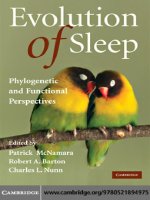0521867061 cambridge university press data analysis using regression and multilevel hierarchical models dec 2006
Bạn đang xem bản rút gọn của tài liệu. Xem và tải ngay bản đầy đủ của tài liệu tại đây (8.78 MB, 651 trang )
This page intentionally left blank
Data Analysis Using Regression and Multilevel/Hierarchical Models
Data Analysis Using Regression and Multilevel/Hierarchical Models is a comprehensive
manual for the applied researcher who wants to perform data analysis using linear and
nonlinear regression and multilevel models. The book introduces and demonstrates a wide
variety of models, at the same time instructing the reader in how to fit these models using
freely available software packages. The book illustrates the concepts by working through
scores of real data examples that have arisen in the authors’ own applied research, with programming code provided for each one. Topics covered include causal inference, including
regression, poststratification, matching, regression discontinuity, and instrumental variables, as well as multilevel logistic regression and missing-data imputation. Practical tips
regarding building, fitting, and understanding are provided throughout.
Andrew Gelman is Professor of Statistics and Professor of Political Science at Columbia
University. He has published more than 150 articles in statistical theory, methods, and
computation and in applications areas including decision analysis, survey sampling, political science, public health, and policy. His other books are Bayesian Data Analysis (1995,
second edition 2003) and Teaching Statistics: A Bag of Tricks (2002).
Jennifer Hill is Assistant Professor of Public Affairs in the Department of International
and Public Affairs at Columbia University. She has coauthored articles that have appeared
in the Journal of the American Statistical Association, American Political Science Review,
American Journal of Public Health, Developmental Psychology, the Economic Journal, and
the Journal of Policy Analysis and Management, among others.
Analytical Methods for Social Research
Analytical Methods for Social Research presents texts on empirical and formal methods
for the social sciences. Volumes in the series address both the theoretical underpinnings
of analytical techniques and their application in social research. Some series volumes are
broad in scope, cutting across a number of disciplines. Others focus mainly on methodological applications within specific fields such as political science, sociology, demography,
and public health. The series serves a mix of students and researchers in the social sciences
and statistics.
Series Editors:
R. Michael Alvarez, California Institute of Technology
Nathaniel L. Beck, New York University
Lawrence L. Wu, New York University
Other Titles in the Series:
Event History Modeling: A Guide for Social Scientists, by Janet M. Box-Steffensmeier
and Bradford S. Jones
Ecological Inference: New Methodological Strategies, edited by Gary King, Ori Rosen,
and Martin A. Tanner
Spatial Models of Parliamentary Voting, by Keith T. Poole
Essential Mathematics for Political and Social Research, by Jeff Gill
Political Game Theory: An Introduction, by Nolan McCarty and Adam Meirowitz
Data Analysis Using Regression and
Multilevel/Hierarchical Models
ANDREW GELMAN
Columbia University
JENNIFER HILL
Columbia University
CAMBRIDGE UNIVERSITY PRESS
Cambridge, New York, Melbourne, Madrid, Cape Town, Singapore, São Paulo
Cambridge University Press
The Edinburgh Building, Cambridge CB2 8RU, UK
Published in the United States of America by Cambridge University Press, New York
www.cambridge.org
Information on this title: www.cambridge.org/9780521867061
© Andrew Gelman and Jennifer Hill 2007
This publication is in copyright. Subject to statutory exception and to the provision of
relevant collective licensing agreements, no reproduction of any part may take place
without the written permission of Cambridge University Press.
First published in print format 2006
ISBN-13
ISBN-10
978-0-511-26878-6 eBook (EBL)
0-511-26878-5 eBook (EBL)
ISBN-13
ISBN-10
978-0-521-86706-1 hardback
0-521-86706-1 hardback
ISBN-13
ISBN-10
978-0-521-68689-1 paperback
0-521-68689-X paperback
Cambridge University Press has no responsibility for the persistence or accuracy of urls
for external or third-party internet websites referred to in this publication, and does not
guarantee that any content on such websites is, or will remain, accurate or appropriate.
Data Analysis Using Regression and
Multilevel/Hierarchical Models
(Corrected final version: 9 Aug 2006)
Please do not reproduce in any form
without permission
Andrew Gelman
Department of Statistics and Department of Political Science
Columbia University, New York
Jennifer Hill
School of International and Public Affairs
Columbia University, New York
c 2002, 2003, 2004, 2005, 2006 by Andrew Gelman and Jennifer Hill
To be published in October, 2006 by Cambridge University Press
For Zacky and for Audrey
Contents
page xvii
List of examples
Preface
xix
1 Why?
1.1 What is multilevel regression modeling?
1.2 Some examples from our own research
1.3 Motivations for multilevel modeling
1.4 Distinctive features of this book
1.5 Computing
1
1
3
6
8
9
2 Concepts and methods from basic probability and statistics
2.1 Probability distributions
2.2 Statistical inference
2.3 Classical confidence intervals
2.4 Classical hypothesis testing
2.5 Problems with statistical significance
2.6 55,000 residents desperately need your help!
2.7 Bibliographic note
2.8 Exercises
13
13
16
18
20
22
23
26
26
Part 1A: Single-level regression
29
3 Linear regression: the basics
3.1 One predictor
3.2 Multiple predictors
3.3 Interactions
3.4 Statistical inference
3.5 Graphical displays of data and fitted model
3.6 Assumptions and diagnostics
3.7 Prediction and validation
3.8 Bibliographic note
3.9 Exercises
31
31
32
34
37
42
45
47
49
49
4 Linear regression: before and after fitting the model
4.1 Linear transformations
4.2 Centering and standardizing, especially for models with interactions
4.3 Correlation and “regression to the mean”
4.4 Logarithmic transformations
4.5 Other transformations
4.6 Building regression models for prediction
4.7 Fitting a series of regressions
53
53
55
57
59
65
68
73
ix
x
CONTENTS
4.8
4.9
Bibliographic note
Exercises
74
74
5 Logistic regression
5.1 Logistic regression with a single predictor
5.2 Interpreting the logistic regression coefficients
5.3 Latent-data formulation
5.4 Building a logistic regression model: wells in Bangladesh
5.5 Logistic regression with interactions
5.6 Evaluating, checking, and comparing fitted logistic regressions
5.7 Average predictive comparisons on the probability scale
5.8 Identifiability and separation
5.9 Bibliographic note
5.10 Exercises
79
79
81
85
86
92
97
101
104
105
105
6 Generalized linear models
6.1 Introduction
6.2 Poisson regression, exposure, and overdispersion
6.3 Logistic-binomial model
6.4 Probit regression: normally distributed latent data
6.5 Multinomial regression
6.6 Robust regression using the t model
6.7 Building more complex generalized linear models
6.8 Constructive choice models
6.9 Bibliographic note
6.10 Exercises
109
109
110
116
118
119
124
125
127
131
132
Part 1B: Working with regression inferences
135
7 Simulation of probability models and statistical inferences
7.1 Simulation of probability models
7.2 Summarizing linear regressions using simulation: an informal
Bayesian approach
7.3 Simulation for nonlinear predictions: congressional elections
7.4 Predictive simulation for generalized linear models
7.5 Bibliographic note
7.6 Exercises
137
137
8 Simulation for checking statistical procedures and model fits
8.1 Fake-data simulation
8.2 Example: using fake-data simulation to understand residual plots
8.3 Simulating from the fitted model and comparing to actual data
8.4 Using predictive simulation to check the fit of a time-series model
8.5 Bibliographic note
8.6 Exercises
155
155
157
158
163
165
165
9 Causal inference using regression on the treatment variable
9.1 Causal inference and predictive comparisons
9.2 The fundamental problem of causal inference
9.3 Randomized experiments
9.4 Treatment interactions and poststratification
167
167
170
172
178
140
144
148
151
152
CONTENTS
9.5
9.6
9.7
9.8
9.9
9.10
Observational studies
Understanding causal inference in observational studies
Do not control for post-treatment variables
Intermediate outcomes and causal paths
Bibliographic note
Exercises
xi
181
186
188
190
194
194
10 Causal inference using more advanced models
199
10.1 Imbalance and lack of complete overlap
199
10.2 Subclassification: effects and estimates for different subpopulations 204
10.3 Matching: subsetting the data to get overlapping and balanced
treatment and control groups
206
10.4 Lack of overlap when the assignment mechanism is known:
regression discontinuity
212
10.5 Estimating causal effects indirectly using instrumental variables
215
10.6 Instrumental variables in a regression framework
220
10.7 Identification strategies that make use of variation within or between
groups
226
10.8 Bibliographic note
229
10.9 Exercises
231
Part 2A: Multilevel regression
235
11 Multilevel structures
11.1 Varying-intercept and varying-slope models
11.2 Clustered data: child support enforcement in cities
11.3 Repeated measurements, time-series cross sections, and other
non-nested structures
11.4 Indicator variables and fixed or random effects
11.5 Costs and benefits of multilevel modeling
11.6 Bibliographic note
11.7 Exercises
237
237
237
12 Multilevel linear models: the basics
12.1 Notation
12.2 Partial pooling with no predictors
12.3 Partial pooling with predictors
12.4 Quickly fitting multilevel models in R
12.5 Five ways to write the same model
12.6 Group-level predictors
12.7 Model building and statistical significance
12.8 Predictions for new observations and new groups
12.9 How many groups and how many observations per group are
needed to fit a multilevel model?
12.10 Bibliographic note
12.11 Exercises
251
251
252
254
259
262
265
270
272
241
244
246
247
248
275
276
277
13 Multilevel linear models: varying slopes, non-nested models, and
other complexities
279
13.1 Varying intercepts and slopes
279
13.2 Varying slopes without varying intercepts
283
xii
CONTENTS
13.3 Modeling multiple varying coefficients using the scaled inverseWishart distribution
13.4 Understanding correlations between group-level intercepts and
slopes
13.5 Non-nested models
13.6 Selecting, transforming, and combining regression inputs
13.7 More complex multilevel models
13.8 Bibliographic note
13.9 Exercises
287
289
293
297
297
298
14 Multilevel logistic regression
14.1 State-level opinions from national polls
14.2 Red states and blue states: what’s the matter with Connecticut?
14.3 Item-response and ideal-point models
14.4 Non-nested overdispersed model for death sentence reversals
14.5 Bibliographic note
14.6 Exercises
301
301
310
314
320
321
322
15 Multilevel generalized linear models
15.1 Overdispersed Poisson regression: police stops and ethnicity
15.2 Ordered categorical regression: storable votes
15.3 Non-nested negative-binomial model of structure in social networks
15.4 Bibliographic note
15.5 Exercises
325
325
331
332
342
342
Part 2B: Fitting multilevel models
343
16 Multilevel modeling in Bugs and R: the basics
16.1 Why you should learn Bugs
16.2 Bayesian inference and prior distributions
16.3 Fitting and understanding a varying-intercept multilevel model
using R and Bugs
16.4 Step by step through a Bugs model, as called from R
16.5 Adding individual- and group-level predictors
16.6 Predictions for new observations and new groups
16.7 Fake-data simulation
16.8 The principles of modeling in Bugs
16.9 Practical issues of implementation
16.10 Open-ended modeling in Bugs
16.11 Bibliographic note
16.12 Exercises
345
345
345
284
348
353
359
361
363
366
369
370
373
373
17 Fitting multilevel linear and generalized linear models in Bugs
and R
375
17.1 Varying-intercept, varying-slope models
375
17.2 Varying intercepts and slopes with group-level predictors
379
17.3 Non-nested models
380
17.4 Multilevel logistic regression
381
17.5 Multilevel Poisson regression
382
17.6 Multilevel ordered categorical regression
383
17.7 Latent-data parameterizations of generalized linear models
384
CONTENTS
17.8 Bibliographic note
17.9 Exercises
xiii
385
385
18 Likelihood and Bayesian inference and computation
18.1 Least squares and maximum likelihood estimation
18.2 Uncertainty estimates using the likelihood surface
18.3 Bayesian inference for classical and multilevel regression
18.4 Gibbs sampler for multilevel linear models
18.5 Likelihood inference, Bayesian inference, and the Gibbs sampler:
the case of censored data
18.6 Metropolis algorithm for more general Bayesian computation
18.7 Specifying a log posterior density, Gibbs sampler, and Metropolis
algorithm in R
18.8 Bibliographic note
18.9 Exercises
387
387
390
392
397
19 Debugging and speeding convergence
19.1 Debugging and confidence building
19.2 General methods for reducing computational requirements
19.3 Simple linear transformations
19.4 Redundant parameters and intentionally nonidentifiable models
19.5 Parameter expansion: multiplicative redundant parameters
19.6 Using redundant parameters to create an informative prior
distribution for multilevel variance parameters
19.7 Bibliographic note
19.8 Exercises
415
415
418
419
419
424
402
408
409
413
413
427
434
434
Part 3: From data collection to model understanding to model
checking
435
20 Sample size and power calculations
20.1 Choices in the design of data collection
20.2 Classical power calculations: general principles, as illustrated by
estimates of proportions
20.3 Classical power calculations for continuous outcomes
20.4 Multilevel power calculation for cluster sampling
20.5 Multilevel power calculation using fake-data simulation
20.6 Bibliographic note
20.7 Exercises
437
437
21 Understanding and summarizing the fitted models
21.1 Uncertainty and variability
21.2 Superpopulation and finite-population variances
21.3 Contrasts and comparisons of multilevel coefficients
21.4 Average predictive comparisons
21.5 R2 and explained variance
21.6 Summarizing the amount of partial pooling
21.7 Adding a predictor can increase the residual variance!
21.8 Multiple comparisons and statistical significance
21.9 Bibliographic note
21.10 Exercises
457
457
459
462
466
473
477
480
481
484
485
439
443
447
449
454
454
xiv
CONTENTS
22 Analysis of variance
22.1 Classical analysis of variance
22.2 ANOVA and multilevel linear and generalized linear models
22.3 Summarizing multilevel models using ANOVA
22.4 Doing ANOVA using multilevel models
22.5 Adding predictors: analysis of covariance and contrast analysis
22.6 Modeling the variance parameters: a split-plot latin square
22.7 Bibliographic note
22.8 Exercises
487
487
490
492
494
496
498
501
501
23 Causal inference using multilevel models
23.1 Multilevel aspects of data collection
23.2 Estimating treatment effects in a multilevel observational study
23.3 Treatments applied at different levels
23.4 Instrumental variables and multilevel modeling
23.5 Bibliographic note
23.6 Exercises
503
503
506
507
509
512
512
24 Model checking and comparison
24.1 Principles of predictive checking
24.2 Example: a behavioral learning experiment
24.3 Model comparison and deviance
24.4 Bibliographic note
24.5 Exercises
513
513
515
524
526
527
25 Missing-data imputation
25.1 Missing-data mechanisms
25.2 Missing-data methods that discard data
25.3 Simple missing-data approaches that retain all the data
25.4 Random imputation of a single variable
25.5 Imputation of several missing variables
25.6 Model-based imputation
25.7 Combining inferences from multiple imputations
25.8 Bibliographic note
25.9 Exercises
529
530
531
532
533
539
540
542
542
543
Appendixes
545
A Six
A.1
A.2
A.3
A.4
A.5
A.6
quick tips to improve your regression modeling
547
Fit many models
547
Do a little work to make your computations faster and more reliable 547
Graphing the relevant and not the irrelevant
548
Transformations
548
Consider all coefficients as potentially varying
549
Estimate causal inferences in a targeted way, not as a byproduct
of a large regression
549
B Statistical graphics for research and presentation
B.1 Reformulating a graph by focusing on comparisons
B.2 Scatterplots
B.3 Miscellaneous tips
551
552
553
559
CONTENTS
B.4
B.5
Bibliographic note
Exercises
xv
562
563
C Software
C.1 Getting started with R, Bugs, and a text editor
C.2 Fitting classical and multilevel regressions in R
C.3 Fitting models in Bugs and R
C.4 Fitting multilevel models using R, Stata, SAS, and other software
C.5 Bibliographic note
565
565
565
567
568
573
References
575
Author index
601
Subject index
607
List of examples
Home radon
3, 36, 252, 279, 479
Forecasting elections
3, 144
State-level opinions from national polls
4, 301, 493
Police stops by ethnic group
5, 21, 112, 325
Public opinion on the death penalty
19
Testing for election fraud
23
Sex ratio of births
27, 137
Mothers’ education and children’s test scores
31, 55
Height and weight
41, 75
Beauty and teaching evaluations
51, 277
Height and earnings
53, 59, 140, 288
Handedness
66
Yields of mesquite bushes
70
Political party identification over time
73
Income and voting
79, 107
Arsenic in drinking water
86, 128, 193
Death-sentencing appeals process
116, 320, 540
Ordered logistic model for storable votes
120, 331
Cockroaches in apartments
126, 161
Behavior of couples at risk for HIV
132, 166
Academy Award voting
133
Incremental cost-effectiveness ratio
152
Unemployment time series
163
The Electric Company TV show
174, 503
Hypothetical study of parenting quality as an intermediate outcome
188
Sesame Street TV show
196
Messy randomized experiment of cow feed
196
Incumbency and congressional elections
197
xvii
xviii
Value of a statistical life
Evaluating the Infant Health and Development Program
LIST OF EXAMPLES
197
201, 506
Ideology of congressmembers
213
Hypothetical randomized-encouragement study
216
Child support enforcement
237
Adolescent smoking
241
Rodents in apartments
248
Olympic judging
248
Time series of children’s CD4 counts
249, 277, 449
Flight simulator experiment
289, 464, 488
Latin square agricultural experiment
292, 497
Income and voting by state
310
Item-response models
314
Ideal-point modeling for the Supreme Court
317
Speed dating
322
Social networks
332
Regression with censored data
402
Educational testing experiments
430
Zinc for HIV-positive children
439
Cluster sampling of New York City residents
448
Value added of school teachers
458
Advanced Placement scores and college grades
463
Prison sentences
470
Magnetic fields and brain functioning
481
Analysis of variance for web connect times
492
Split-plot latin square
498
Educational-subsidy program in Mexican villages
508
Checking models of behavioral learning in dogs
515
Missing data in the Social Indicators Survey
529
Preface
Aim of this book
This book originated as lecture notes for a course in regression and multilevel modeling, offered by the statistics department at Columbia University and attended
by graduate students and postdoctoral researchers in social sciences (political science, economics, psychology, education, business, social work, and public health)
and statistics. The prerequisite is statistics up to and including an introduction to
multiple regression.
Advanced mathematics is not assumed—it is important to understand the linear
model in regression, but it is not necessary to follow the matrix algebra in the
derivation of least squares computations. It is useful to be familiar with exponents
and logarithms, especially when working with generalized linear models.
After completing Part 1 of this book, you should be able to fit classical linear and
generalized linear regression models—and do more with these models than simply
look at their coefficients and their statistical significance. Applied goals include
causal inference, prediction, comparison, and data description. After completing
Part 2, you should be able to fit regression models for multilevel data. Part 3
takes you from data collection, through model understanding (looking at a table of
estimated coefficients is usually not enough), to model checking and missing data.
The appendixes include some reference materials on key tips, statistical graphics,
and software for model fitting.
What you should be able to do after reading this book and working through the
examples
This text is structured through models and examples, with the intention that after
each chapter you should have certain skills in fitting, understanding, and displaying
models:
• Part 1A: Fit, understand, and graph classical regressions and generalized linear
models.
– Chapter 3: Fit linear regressions and be able to interpret and display estimated
coefficients.
– Chapter 4: Build linear regression models by transforming and combining
variables.
– Chapter 5: Fit, understand, and display logistic regression models for binary
data.
– Chapter 6: Fit, understand, and display generalized linear models, including
Poisson regression with overdispersion and ordered logit and probit models.
• Part 1B: Use regression to learn about quantities of substantive interest (not
just regression coefficients).
– Chapter 7: Simulate probability models and uncertainty about inferences and
predictions.
xix
xx
PREFACE
– Chapter 8: Check model fits using fake-data simulation and predictive simulation.
– Chapter 9: Understand assumptions underlying causal inference. Set up regressions for causal inference and understand the challenges that arise.
– Chapter 10: Understand the assumptions underlying propensity score matching, instrumental variables, and other techniques to perform causal inference
when simple regression is not enough. Be able to use these when appropriate.
• Part 2A: Understand and graph multilevel models.
– Chapter 11: Understand multilevel data structures and models as generalizations of classical regression.
– Chapter 12: Understand and graph simple varying-intercept regressions and
interpret as partial-pooling estimates.
– Chapter 13: Understand and graph multilevel linear models with varying intercepts and slopes, non-nested structures, and other complications.
– Chapter 14: Understand and graph multilevel logistic models.
– Chapter 15: Understand and graph multilevel overdispersed Poisson, ordered
logit and probit, and other generalized linear models.
• Part 2B: Fit multilevel models using the software packages R and Bugs.
– Chapter 16: Fit varying-intercept regressions and understand the basics of
Bugs. Check your programming using fake-data simulation.
– Chapter 17: Use Bugs to fit various models from Part 2A.
– Chapter 18: Understand Bayesian inference as a generalization of least squares
and maximum likelihood. Use the Gibbs sampler to fit multilevel models.
– Chapter 19: Use redundant parameterizations to speed the convergence of the
Gibbs sampler.
• Part 3:
– Chapter 20: Perform sample size and power calculations for classical and hierarchical models: standard-error formulas for basic calculations and fake-data
simulation for harder problems.
– Chapter 21: Calculate and understand contrasts, explained variance, partial
pooling coefficients, and other summaries of fitted multilevel models.
– Chapter 22: Use the ideas of analysis of variance to summarize fitted multilevel
models; use multilevel models to perform analysis of variance.
– Chapter 23: Use multilevel models in causal inference.
– Chapter 24: Check the fit of models using predictive simulation.
– Chapter 25: Use regression to impute missing data in multivariate datasets.
In summary, you should be able to fit, graph, and understand classical and multilevel linear and generalized linear models and to use these model fits to make
predictions and inferences about quantities of interest, including causal treatment
effects.
PREFACE
xxi
Data for the examples and homework assignments and other resources for
teaching and learning
The website www.stat.columbia.edu/∼gelman/arm/ contains datasets used in the
examples and homework problems of the book, as well as sample computer code.
The website also includes some tips for teaching regression and multilevel modeling
through class participation rather than lecturing. We plan to update these tips
based on feedback from instructors and students; please send your comments and
suggestions to
Outline of a course
When teaching a course based on this book, we recommend starting with a selfcontained review of linear regression, logistic regression, and generalized linear models, focusing not on the mathematics but on understanding these methods and implementing them in a reasonable way. This is also a convenient way to introduce the
statistical language R, which we use throughout for modeling, computation, and
graphics. One thing that will probably be new to the reader is the use of random
simulations to summarize inferences and predictions.
We then introduce multilevel models in the simplest case of nested linear models,
fitting in the Bayesian modeling language Bugs and examining the results in R.
Key concepts covered at this point are partial pooling, variance components, prior
distributions, identifiability, and the interpretation of regression coefficients at different levels of the hierarchy. We follow with non-nested models, multilevel logistic
regression, and other multilevel generalized linear models.
Next we detail the steps of fitting models in Bugs and give practical tips for reparameterizing a model to make it converge faster and additional tips on debugging.
We also present a brief review of Bayesian inference and computation. Once the
student is able to fit multilevel models, we move in the final weeks of the class to
the final part of the book, which covers more advanced issues in data collection,
model understanding, and model checking.
As we show throughout, multilevel modeling fits into a view of statistics that
unifies substantive modeling with accurate data fitting, and graphical methods are
crucial both for seeing unanticipated features in the data and for understanding the
implications of fitted models.
Acknowledgments
We thank the many students and colleagues who have helped us understand and
implement these ideas. Most important have been Jouni Kerman, David Park, and
Joe Bafumi for years of suggestions throughout this project, and for many insights
into how to present this material to students.
In addition, we thank Hal Stern and Gary King for discussions on the structure
of this book; Chuanhai Liu, Xiao-Li Meng, Zaiying Huang, John Boscardin, Jouni
Kerman, and Alan Zaslavsky for discussions about statistical computation; Iven
Van Mechelen and Hans Berkhof for discussions about model checking; Iain Pardoe for discussions of average predictive effects and other summaries of regression
models; Matt Salganik and Wendy McKelvey for suggestions on the presentation
of sample size calculations; T. E. Raghunathan, Donald Rubin, Rajeev Dehejia,
Michael Sobel, Guido Imbens, Samantha Cook, Ben Hansen, Dylan Small, and Ed
Vytlacil for concepts of missing-data modeling and causal inference; Eric Loken for
help in understanding identifiability in item-response models; Niall Bolger, Agustin









